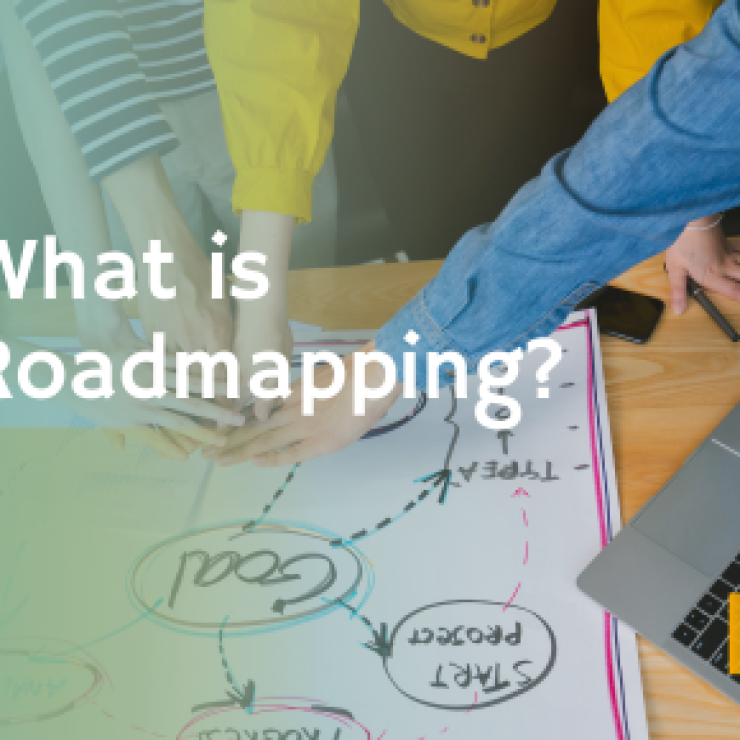Roadmapping describes the process of creating a roadmap. A roadmap is nothing more than a visual roadmap that shows the steps to achieve strategic goals on a timeline. Roadmaps can represent a high-level perspective or be very specific, depending on the purpose.
Imagine you are founding a company, developing a new product or leading a group-wide project. It’s all based on a vision, for sure – but how do you turn it into reality? How do you keep the long-term overview of the most important steps? How do you make sure you don’t get bogged down in the details? Good news: This is exactly where roadmaps or road mapping come into play.
What is a roadmap?
Let’s start with a brief explanation of terms: A roadmap is nothing more than a timetable. This clearly shows how strategic goals are to be achieved. Roadmaps are created when there is strategic planning, and the results are clearly visualized.
A roadmap is the visual result of a strategic planning process and is used to communicate the developed strategy.
Product Roadmaps can look at an entire company from a high-level perspective (“Where are we and where do we want to be in the next few years?”), but they can also be created in great detail for a specific product (“What happens when?”).
As you can see: Different levels of detail, different purposes – apparently, there is no such thing as THE roadmap. However, most roadmaps have a common denominator: Topics or task blocks are displayed on a timeline in such a way that everyone involved receives an answer to the following question:
What do we want to do when?
Example:
In a medium-sized company that manufactures kitchen accessories, new products are introduced and existing ones improved. A roadmap visualizes what should happen when in the long term for everyone involved. Concrete deadlines often play a subordinate role – it is important to look at the big picture. The roadmap is maintained in PowerPoint, updated at regular intervals and printed out in large format so that everyone involved can see the timetable.
What is road mapping?
Short and painless: roadmapping is nothing other than the process in which a roadmap is created. In this process, steps, measures and resources are determined in order to make a vision a reality. To put it in a somewhat more German but longer way, one could also speak of the “development/creation of a roadmap” instead of “roadmapping.”
Roadmapping usually takes place in a team and can be done using a wide variety of tools: from Excel spreadsheets to Kanban boards, PowerPoint slides or graphics in special roadmapping tools, everything is possible.
One of the most important steps in the road mapping is sharing and communicating the roadmap to key audiences such as team members, other departments, or senior management.
Example:
New features are to be implemented in time tracking apps, such as a reminder function, the option to upload individual background images and the export of reports. The vision “Time recording made easy for everyone” is first entered on the roadmap. Each feature is inserted as a single element, including a short description and the responsible sub-project manager. In the last step, the features are shifted along the timeline: what will be implemented first, and what will come later? This roadmap serves as the basis for the joint work and is used in status meetings and reviews.
Types of roadmaps
In road mapping, there is only one way. Not even close! There are a number of roadmaps for different topics :
- technology roadmap
- Product and innovation roadmap
- IT/Software Roadmap
- Agile roadmaps
- HR roadmap
- content roadmap
- Integrated roadmap
- Company-wide roadmap
- Change roadmap (roadmap in a change process)
Depending on the company, the goal and the level of detail, these roadmaps can look very different depending on the priorities and requirements.
There will soon be a separate article on this topic. Subscribe to our newsletter, and we will inform you as soon as the article appears.
Content of a roadmap
Although there are many different types of roadmaps, you will almost always find the following elements:
- Timeline: A roadmap usually provides a glimpse into the future. The time axis often extends over several months to years.
- Goals or subject areas The most important goals or subject areas are usually defined in the left area.
- Projects or task blocks: The projects or task blocks that are necessary to achieve the goals are arranged in the main area of the roadmap.
- Persons responsible: Optionally, the persons responsible can be entered.
- Dates: Important dates such as milestones or reviews can also be included.
- Progress: You can also visualize the progress of task blocks by shading bars.
Difference between road mapping and project planning
Now you might be thinking: “Mooooment… Goals, tasks, responsible persons and deadlines: What’s the difference between the project plan?” Good question! Let’s look at two differences:
- Perspective: A roadmap is more often created from a “high-level” perspective and gives an overview of an entire company, an entire department or a specific product. A project plan, on the other hand, is much more detailed with concrete expenses and deadlines.
- Project focus: A roadmap is often (but not always) created across projects, while a project plan is related to a single project.
- Time frame: While a roadmap often looks into the future (more) long-term, a project plan is limited to the duration of the project. In practice, the methods are used differently; sometimes, the transitions are fluid. In addition to the typical high-level roadmaps for long-term strategic planning, roadmaps are also used, which in practice are nothing more than a project plan, including detailed tasks, resources and expenses.
Roadmapping Benefits
Roadmaps have a number of advantages that you will definitely benefit from:
Visualize the vision: With a roadmap, you visualize how to implement a vision. This can be a vision for a product (“Our chair should support our customers’ backs,” a service (“Our app should enable customers to pay quickly, easily and without worries”) or for an entire company (“With our data protection company, customers feel safe”).
Promotes communication: By showing chronological and logical links over a longer period of time, a common picture is created that can be used as a basis for discussions between the various participants.
Link Goals: Goals of a department or company division are linked to the overall strategy of the company. This creates transparency for everyone.
Increases understanding: why are we doing what? Why is this important? A roadmap clearly shows which steps are necessary to achieve higher-level business goals.
Simplified prioritization: The roadmap shows a way to achieve the goals and visions and thus defines clear priorities. Is a marginal topic that seems particularly exciting but neither serves to achieve the goal nor is it included in the roadmap? Then it should not be prioritized.
It is visual: pictures say more than words. Imagine you had to convey all of the above information in text form in a Word document – well then, have fun in the next meeting!
You see: Roadmaps motivate, set a clear focus and promote communication in teams, companies or in front of financiers.
Conclusion
A roadmap looks to the future and is a visualization of a strategic plan. If you use roadmaps in your company or project, you give everyone involved a visual overview of your project and chronological and logical sequences, increase acceptance and ensure that everyone has the goals clearly in mind.
By thinking about many important points such as vision and participants in advance, you will also benefit from the roadmap created in the actual project (or the projects if there are several) – regardless of whether it is about product development, optimizing services or setting up or expansion of entire companies.




